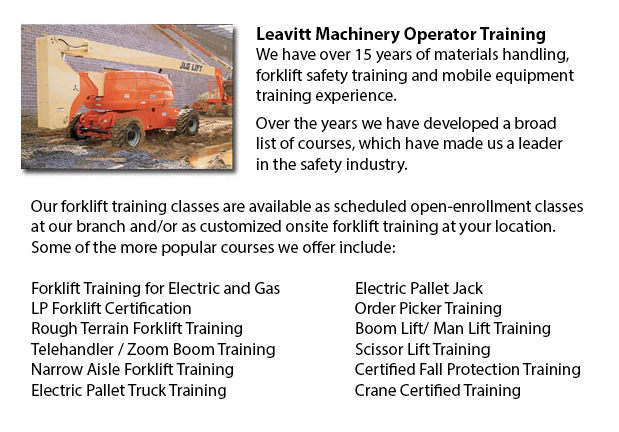
Kelowna Aerial Boom Lift Training - For those who operate or supervise the use of aerial lift platforms, correct aerial boom lift Training is required. The aerial lift platform is used for lifting people, tools and materials to elevated work locations. They are normally used to access other above ground job-sites and utility lines. There are various types of aerial booms lifts, such as extension boom lifts, cherry pickers and articulating boom lifts. There are two types of boom lift: "telescopic" and "knuckle".
Training in the essential equipment, safety and operations issues involved in boom lifts is important. Workers need to understand the rules, dangers, and safe work practices whilst working among mobile equipment. Training course materials offer an introduction to the uses, terms, concepts and skills required for employees to gain experience in operating boom lifts. The material is aimed at machine operators, safety professionals and workers.
This training is cost-effective, educational and adaptive for your business. A safe and effective workplace can help a business achieve overall high levels of production. Less workplace accidents happen in workplaces with strict safety policies. All machine operators must be trained and evaluated. They need understanding of existing safety measures. They must comprehend and follow guidelines set forth by their employer and local governing authorities.
Employers must make sure that their employees who operate aerial boom lifts get right training in their safe use. Operator certification is required on every different type of aerial machinery utilized in the workplace. Certifications are available for aerial work platforms, articulating booms, industrial forklift trucks, scissor lifts, etc. Employees who are completely trained work more effectively and efficiently compared to untrained workers, who need more supervision. Correct instruction and training saves resources in the long run.
Training is the best prevention for the primary causes of workplace fatalities: electrocutions, falls and collapses or tip overs. Aside from training, the best way to prevent workplace accidents is to maintain and operate aerial work platforms according to the instructions of the manufacturer. Allow for the total weight of the materials, worker and tools when following load restrictions. Never override hydraulic, mechanical or electrical safety devices. Employees must be securely held within the basket making use of a restraining belt or body harness with an attached lanyard. Do not move lift equipment whilst employees are on the elevated platform. Workers must take care not to position themselves between the joists or beams and basket rails in order to avoid being crushed. Energized overhead power lines must be at least 10 feet away from the lift equipment. It is suggested that workers always assume wires and power lines might be energized, even if they are down or seem to be insulated. If working on an incline, set brakes and make use of wheel chocks.
-
Kelowna Forklift Training Program
Kelowna Forklift Training Program - The lift truck is a common powered industrial vehicle which is in wide use these days. They are sometimes called hi los, lift trucks or jitneys. A departments store would use the forklift to unload and load merchan... More -
Kelowna Crane License
Kelowna Crane License - Crane operators ought to be "credentialed", that means they ought to have a crane operator certification or license. Credentialing is considered a mandatory governmental requirement in order to practice as an operator of a cra... More -
Kelowna Boom Lift Safety Training
Kelowna Boom Lift Safey Training - Boom lifts fall under the type of elevated work platform or aerial lifting device. Most usually used in warehousing, construction and industry; the boom lift is so versatile that it could be utilized in almost whate... More -
Kelowna Loader Training
Kelowna Loader Training - Loader Training - Any individual who would like to operate a forklift should take a Loader Training course in order to become a certified forklift truck operator. There are a variety of ways to obtain forklift training. Cour... More -
Kelowna Aerial Lift Safety Training
Kelowna Aerial Lift Safety Training - Each and every year, there are roughly 26 construction deaths attributed to the use of aerial lifts. Most of the craftsmen killed are electrical workers, laborers, painters, ironworkers or carpenters. The majorit... More -
Kelowna Crane Ticket
Kelowna Crane Ticket - Modern cranes can either be simple or complex, based upon the nature of the application they can carry out. For example, mobile cranes are somewhat simple units. A telescopic boom and even a steel truss mounts its movable platf... More -
Kelowna Boom Lift Operator Training
Kelowna Boom Lift Operator Training - The cherry picker work platform is a type of work platform, that will typically have a bucket or platform at the end of a hydraulic lifting system. The machine is likewise referred to as a man lift, boom lift, hy... More -
Kelowna Heavy Equipment Ticket
Kelowna Heavy Equipment Ticket - Depending on the nature of the job at hand, the kind of construction equipment that a heavy equipment operator makes use of differs. Every kind of machine is made to perform particular tasks in the most effective mann... More

Leavitt Operator Training
TOLL FREE: 1-888-254-6157
101-864 McCurdy Place
Kelowna, British Columbia
forkliftcertificationkelowna.com
Email Us
About Us


